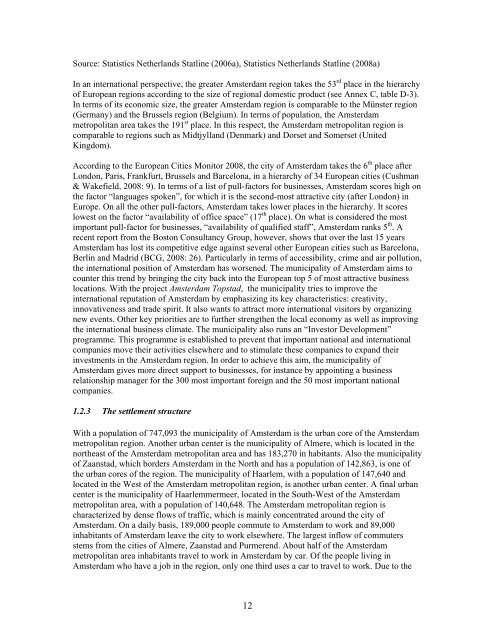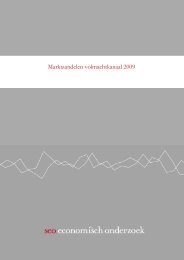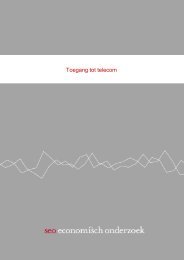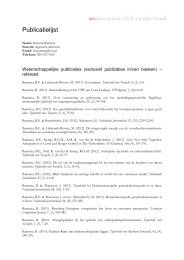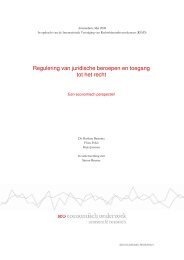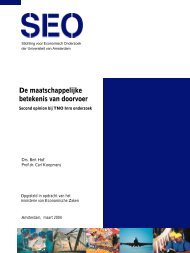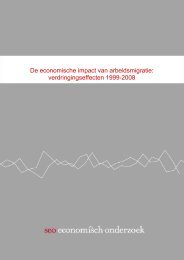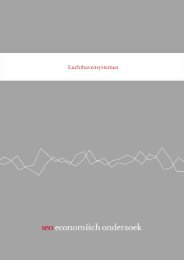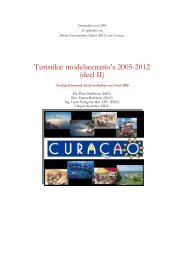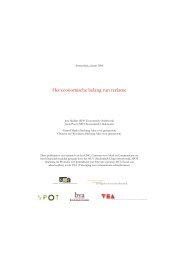Source: Statistics <strong>Netherlands</strong> Statline (2006a), Statistics <strong>Netherlands</strong> Statline (2008a)In an international perspective, the greater <strong>Amsterdam</strong> region takes the 53 rd place in the hierarchyof European regions according to the size of regional domestic product (see Annex C, table D-3).In terms of its economic size, the greater <strong>Amsterdam</strong> region is comparable to the Münster region(Germany) and the Brussels region (Belgium). In terms of population, the <strong>Amsterdam</strong>metropolitan area takes the 191 st place. In this respect, the <strong>Amsterdam</strong> metropolitan region iscomparable to regions such as Midtjylland (Denmark) and Dorset and Somerset (UnitedKingdom).According to the European Cities Monitor 2008, the city of <strong>Amsterdam</strong> takes the 6 th place afterLondon, Paris, Frankfurt, Brussels and Barcelona, in a hierarchy of 34 European cities (Cushman& Wakefield, 2008: 9). In terms of a list of pull-factors for businesses, <strong>Amsterdam</strong> scores high onthe factor “languages spoken”, for which it is the second-most attractive city (after London) inEurope. On all the other pull-factors, <strong>Amsterdam</strong> takes lower places in the hierarchy. It scoreslowest on the factor “availability of office space” (17 th place). On what is considered the mostimportant pull-factor for businesses, “availability of qualified staff”, <strong>Amsterdam</strong> ranks 5 th . Arecent report from the Boston Consultancy Group, however, shows that over the last 15 years<strong>Amsterdam</strong> has lost its competitive edge against several other European cities such as Barcelona,Berlin and Madrid (BCG, 2008: 26). Particularly in terms of accessibility, crime and air pollution,the international position of <strong>Amsterdam</strong> has worsened. The municipality of <strong>Amsterdam</strong> aims tocounter this trend by bringing the city back into the European top 5 of most attractive businesslocations. With the project <strong>Amsterdam</strong> Topstad, the municipality tries to improve theinternational reputation of <strong>Amsterdam</strong> by emphasizing its key characteristics: creativity,innovativeness and trade spirit. It also wants to attract more international visitors by organizingnew events. Other key priorities are to further strengthen the local economy as well as improvingthe international business climate. The municipality also runs an “Investor Development”programme. This programme is established to prevent that important national and internationalcompanies move their activities elsewhere and to stimulate these companies to expand theirinvestments in the <strong>Amsterdam</strong> region. In order to achieve this aim, the municipality of<strong>Amsterdam</strong> gives more direct support to businesses, for instance by appointing a businessrelationship manager for the 300 most important foreign and the 50 most important nationalcompanies.1.2.3 The settlement structureWith a population of 747,093 the municipality of <strong>Amsterdam</strong> is the urban core of the <strong>Amsterdam</strong>metropolitan region. Another urban center is the municipality of Almere, which is located in thenortheast of the <strong>Amsterdam</strong> metropolitan area and has 183,270 in habitants. Also the municipalityof Zaanstad, which borders <strong>Amsterdam</strong> in the North and has a population of 142,863, is one ofthe urban cores of the region. The municipality of Haarlem, with a population of 147,640 andlocated in the West of the <strong>Amsterdam</strong> metropolitan region, is another urban center. A final urbancenter is the municipality of Haarlemmermeer, located in the South-West of the <strong>Amsterdam</strong>metropolitan area, with a population of 140,648. The <strong>Amsterdam</strong> metropolitan region ischaracterized by dense flows of traffic, which is mainly concentrated around the city of<strong>Amsterdam</strong>. On a daily basis, 189,000 people commute to <strong>Amsterdam</strong> to work and 89,000inhabitants of <strong>Amsterdam</strong> leave the city to work elsewhere. The largest inflow of commutersstems from the cities of Almere, Zaanstad and Purmerend. About half of the <strong>Amsterdam</strong>metropolitan area inhabitants travel to work in <strong>Amsterdam</strong> by car. Of the people living in<strong>Amsterdam</strong> who have a job in the region, only one third uses a car to travel to work. Due to the12
elatively bad accessibility of the inner city of <strong>Amsterdam</strong> and traffic jams in and around<strong>Amsterdam</strong>, most inhabitants of <strong>Amsterdam</strong> choose to travel by bike or public transport.Closely related to the daily flow of commuters moving out of <strong>Amsterdam</strong> is the process ofsuburbanization. The <strong>Amsterdam</strong> region is facing a migration deficit for businesses in terms ofthe number of businesses as well as the number of individuals employed at those businesses (EZ<strong>Amsterdam</strong>, 2006). To counter this trend, the city of <strong>Amsterdam</strong> is heavily investing in thedevelopment of office space. Its largest and most prestigious project is the development of theZuidas business district along the A10 highway in Southern <strong>Amsterdam</strong>. At this moment theZuidas district has 270,000 m 2 of office space and provides for 30,000 jobs. Located on theZuidas are mainly financial institutions and professional services firms, as well as VU University<strong>Amsterdam</strong> and VUmc medical center. In addition, the municipality also invests in thedevelopment of office space in other areas in <strong>Amsterdam</strong>, particularly in the boroughs Westpoort,Zuidoost and Noord. Estimates from 2005 indicate that the municipality of <strong>Amsterdam</strong> hascreated enough development capacity to increase the amount of office space with 56% ifnecessary. The boroughs Westpoort and Zuidoost are characterized by large business districts.The borough Noord is a hotspot for the creative industry, which accounts for a substantial shareof the growth in business locations and employment there (TNO, 2004).1.2.4 Location of Higher Education InstitutesThe <strong>Amsterdam</strong> metropolitan region has a high concentration of Higher Education Institutions(HEIs). Most HEIs are located in the capital city of <strong>Amsterdam</strong>. The largest ones are the VUUniversity <strong>Amsterdam</strong>, University of <strong>Amsterdam</strong>, Hogeschool INHolland and Hogeschool van<strong>Amsterdam</strong>. A number of higher education institutes have multiple locations in the <strong>Amsterdam</strong>metropolitan area: Hogeschool INHolland, Hogeschool van <strong>Amsterdam</strong>, Hogeschool IPABO,Hogeschool Markus Verbeek, Hogeschool TIO, Hogeschool Praehep, Stichting Hoger OnderwijsNOVI, Hogeschool Thorbecke and Hogeschool Haarlem. There is also the opportunity ofdistance learning. In 1984, the Open University of the <strong>Netherlands</strong> was established in order tooffer adults a means of pursuing higher education without formal admission requirements and attheir own pace, through distance education (MinOCW, 2007a: 68). The Open University mayoffer both HBO and university courses. HBO is the Dutch equivalent for University of AppliedSciences (hereafter UAS). Other popular institutes that offer courses at HBO or university levelby distance learning are the Leidse Onderwijsinstellingen (LOI) and NCOI. Like the OpenUniversity, they often do not demand a particular educational background from their students.Table 1-2: Higher Education Institutions in the <strong>Amsterdam</strong> metropolitan regionInstitution City Type of HEI InstitutionaltypeUniversity of <strong>Amsterdam</strong> University Multi-sector<strong>Amsterdam</strong>VU University <strong>Amsterdam</strong> University Multi-sector<strong>Amsterdam</strong>Hogeschool van <strong>Amsterdam</strong>, Almere UAS Multi-sector<strong>Amsterdam</strong>HogeschoolINHollandGerrit RietveldAcademieAmstelveen,<strong>Amsterdam</strong>, Diemen,Haarlem and VelsenUASMulti-sector<strong>Amsterdam</strong> UAS Mono-sector(arts)13
- Page 1 and 2: Please cite this paper as:SEO Econo
- Page 6 and 7: 2.3 Higher education and the labor
- Page 8 and 9: 6.3 Mechanisms to promote regional
- Page 10 and 11: Table 4-4: Completion rates of diff
- Page 12 and 13: LSCA Life Sciences Center Amsterdam
- Page 14 and 15: such as regional authorities and th
- Page 17 and 18: 1. OVERVIEW OF THE REGION1.1 Introd
- Page 19: the southEastern part of Amsterdam
- Page 23 and 24: metropolitan area exceeded that of
- Page 25: egion suffer from one of the follow
- Page 28 and 29: Figure 1-7: Dropouts secondary educ
- Page 30 and 31: Figure 1-9: Employment in Amsterdam
- Page 32 and 33: high-tech sectors is relatively hig
- Page 34 and 35: 1.4.4 Labor market indicatorsTable
- Page 36 and 37: The central government is responsib
- Page 38 and 39: implemented. There is also an admin
- Page 41 and 42: 2 CHARACTERISTICS OF THE HIGHER EDU
- Page 43 and 44: Source: MinOCW (2007a: 68), EU (199
- Page 45 and 46: (ibid: 83). In part, this new syste
- Page 47 and 48: Table 2-1: Student enrolment at UAS
- Page 49 and 50: Figure 2-5: Students at universitie
- Page 51 and 52: Figure 2-6: Participation in tertia
- Page 53 and 54: also show a continued high demand f
- Page 55 and 56: not receive funding from the govern
- Page 57 and 58: of diplomas awarded and the number
- Page 59: decision is up to the HEI itself. I
- Page 62 and 63: Figure 3-1: Components of an innova
- Page 64 and 65: 3.2.3 National funding frameworkThe
- Page 66 and 67: challenge for the years to come wil
- Page 68 and 69: Figure 3-3: R&D expenditures in Noo
- Page 70 and 71:
Amsterdam Topstad programme.Creativ
- Page 72 and 73:
3.5.3 Life SciencesGiven the high l
- Page 74 and 75:
Figure 3-4: Employment in Amsterdam
- Page 76 and 77:
years. Employment in the trade and
- Page 78 and 79:
employment has no upward or downwar
- Page 80 and 81:
and more efficient exploitation of
- Page 82 and 83:
mostly happens in the context of R&
- Page 84 and 85:
income related to IP rights. The fa
- Page 86 and 87:
Figure 3-6: Regional innovation sys
- Page 88 and 89:
HEIs to play this role, as it draws
- Page 91 and 92:
4 CONTRIBUTION OF TEACHING & LEARNI
- Page 93 and 94:
housing market, on the ‘buying ma
- Page 95 and 96:
transport, finance, financial manag
- Page 97 and 98:
HvA participates in several initiat
- Page 99 and 100:
4.4 Student recruitment and regiona
- Page 101 and 102:
4.4.1.2 Recruitment of foreign stud
- Page 103 and 104:
• HvA has made its educational pr
- Page 105 and 106:
The HEIs have several external and
- Page 107 and 108:
Table 4-4: Completion rates of diff
- Page 109 and 110:
4.7 Enhancing the regional learning
- Page 111 and 112:
4.8 ConclusionTable 4-6: SWOTStreng
- Page 113:
Amsterdam is matched by a relative
- Page 116 and 117:
The challenge for future social pol
- Page 118 and 119:
The VU likewise develops research p
- Page 120 and 121:
directing, documentary directing, s
- Page 122 and 123:
the university to improve its energ
- Page 125 and 126:
6.1 Introduction6 CAPACITY BUILDING
- Page 127 and 128:
Figure 6-1: Organization chart Vrij
- Page 129 and 130:
There are also examples of more spe
- Page 131 and 132:
Box 6-2: Obstacles for collaboratio
- Page 133 and 134:
eyond labor market studies, there a
- Page 135 and 136:
7 CONCLUSIONS: MOVING BEYOND THE SE
- Page 137 and 138:
…requires different forms of coop
- Page 139 and 140:
at higher levels in order to mainta
- Page 141 and 142:
to increase the interaction between
- Page 143 and 144:
mobility in the world is slackening
- Page 145 and 146:
ecause they are better informed abo
- Page 147 and 148:
REFERENCESAalders, R., A. Bakkeren,
- Page 149 and 150:
EZ Amsterdam (2006), “Research Bu
- Page 151 and 152:
MinOCW (2007a), “The Education Sy
- Page 153 and 154:
SER (2008), “Duurzame Globaliseri
- Page 155:
Versleijen, A., van der Meulen, B.,
- Page 158 and 159:
Institution City Type ofHEIANNEX B:
- Page 160 and 161:
Groningenculture)Hogeschool Amsterd
- Page 163 and 164:
ANNEX C: KEY ECONOMIC INDICATORSTab
- Page 165 and 166:
ANNEX E: REGIONAL PARTNERSHIPS OF A
- Page 167 and 168:
AmsterdamUniversity CollegeOther re
- Page 169 and 170:
ANNEX F: BUSINESSES REPRESENTED IN
- Page 171 and 172:
GLOSSARYBologna DeclarationForeign


